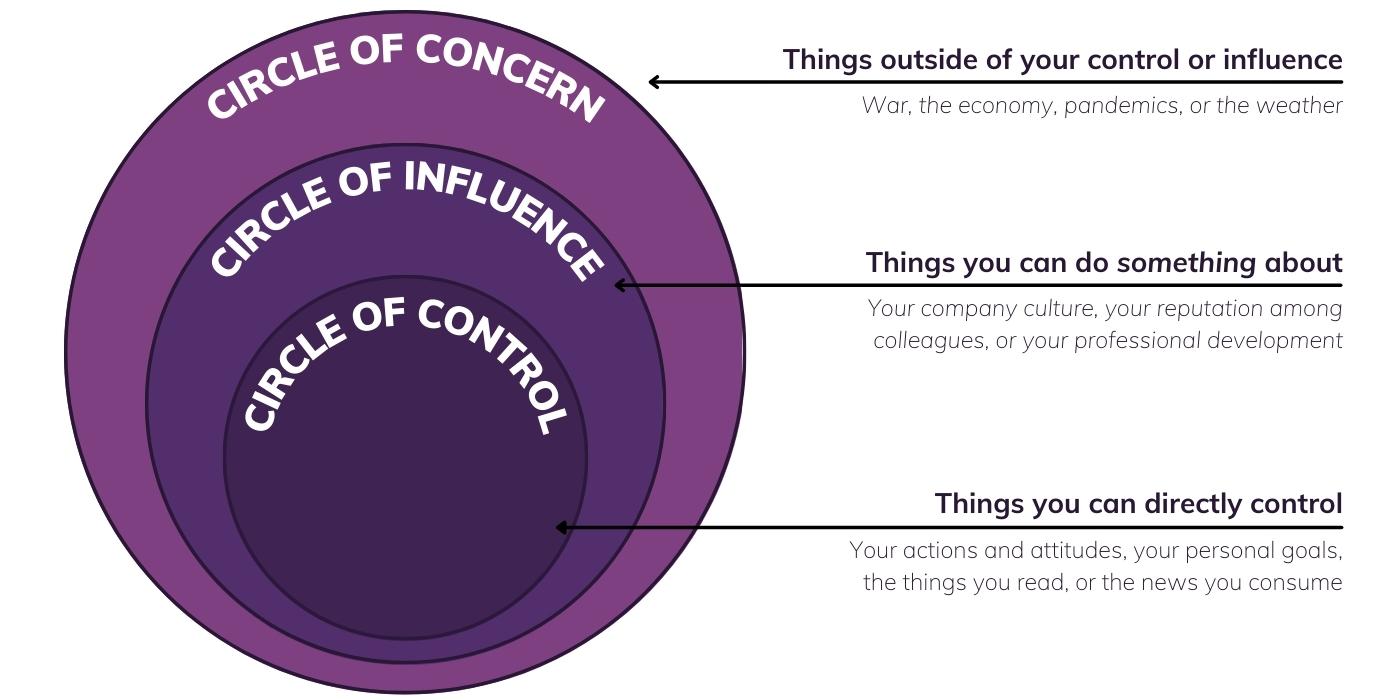
Fundraising is a career in which many of the required results of our job are ultimately decided by people and forces outside of our control. We ask individuals to willingly give money away, not for financial gains or returns, but out of human empathy and belief in mission and impact. We have chosen a career where we are not the decision makers.
For this reason, our unusual (but very rewarding) profession can feel overwhelming and sometimes paralyzing during times of uncertainty, such as market volatility, controversies at our institutions, or leadership transitions.
Data consistently demonstrates that giving continues even in times of market volatility and recession. While the historical evidence is certainly encouraging, when we think about our individual donors, finding the gumption to make an ask or to engage with our constituents can be a bit more challenging.
In these instances, I encourage fundraisers to reflect on their Circles of Influence, Concern, and Control.
What are the Circles of Influence, Concern, & Control?
The Circles of Influence, Concern, and Control create a framework for understanding and managing the aspects of one’s life that one can influence or control. Generally referred to as simply “The Circles of Influence,” the model provides three areas where we can choose to put our focus:
- The Circle of Concern: This circle represents the things that we worry about, but that we do not have direct control over. Examples might include global economic conditions, natural disasters, or geopolitical conflict.
- The Circle of Influence: This circle represents the things that we can do something about, either directly or indirectly. These might include our working conditions, the people we interact with on a daily basis, and our reputations.
- The Circle of Control: This circle represents the things that we are directly responsible for, and that we have complete control over. These might include our own personal habits, our work tasks and responsibilities, and our own goals and objectives.
Focusing on issues within the Circle of Concern expends time and energy on things you can’t do anything about. Not only does this create stress and anxiety; it does little to move projects forward.
When we focus our efforts on the issues that fall within our Circle of Influence, our actions begin to make a positive difference on relationships and results. By doing so, the circle expands, giving you more opportunities for influence and control.
Applying the Circles of Influence in Fundraising
Using the Circles of Influence framework can move a fundraiser from anxiety and inaction onto a path of productivity. To apply it in your work, start by brainstorming a list of the areas of concern, influence, and control for your position. Below are some suggestions to get you started.
What can you CONTROL?
- Your communication: Keep reaching out to existing contacts and continue building relationships, even if they don’t respond right away. Being present and persistent helps you to stay top of mind when they are ready to connect. Too many times fundraisers use a moment of uncertainty as an excuse to cease communications. Instead, view your outreach as one of the few things you can control and use it as an opportunity to press thoughtfully forward.
- Your focus: Time and energy are limited resources, and where we choose to spend them matters. Rather than watching market coverage or reading doom-and-gloom articles, focus on aspects of your work that you can control and advance. Extra time spent here can help you maintain a positive outlook in times of uncertainty.
- For those who manage teams: Take extra time and intentionality when communicating expectations and updates in times of stress so that your team doesn’t fill the silence with incorrect assumptions. Just as you will continue to press forward with your own activity, confirm with your team members what they should press forward within their roles and how they should approach it.
What can you INFLUENCE?
- Your donors: Don’t make assumptions about how issues outside of your control, such as economic downturns or leadership transitions, are impacting donors. Perhaps they are outperforming the market or were ready for a change at your organization. Instead, reach out. You can still be a positive influence on their perceptions of the organization, even if now is not the right time for a gift.
- For those who manage teams: Continue to share information even about matters that you do not control. Understand how your team is feeling about “uncontrollable” items so that you can explore avenues of influence that you do have. Advocate for your team to leadership as much as possible and share stories of success.
What is UNCONTROLLABLE? If I cannot control or influence, can I ACCEPT it?
- Distractions: Acknowledge what is uncontrollable (the markets, transitions at your institution, etc.) and be informed, but do not dwell here. Consider if there are aspects of the uncontrollable you can influence. If you cannot control or influence an issue, do your best to accept it and save your energy for where you can make a difference.
Wrapping Up
We all worry about the future from time to time, but we can’t let that worry stop us from moving forward. Applying the Circle of Influence framework to your work as a fundraiser will help you navigate through uncertainty and prioritize the tasks that will have the most impact.


